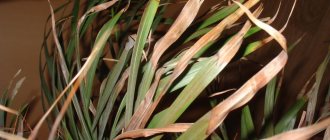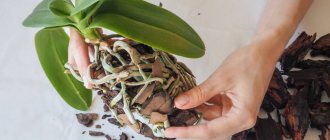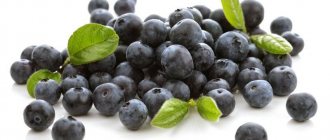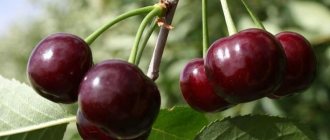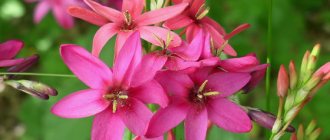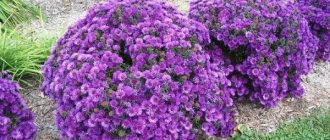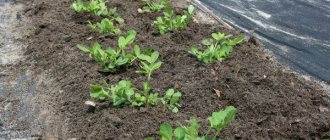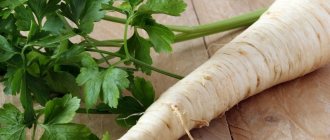Category: Care Published 04/18/2019 · Comments: · Reading time: 8 min · Views: 2,563
Date palms grow throughout tropical and subtropical climates. In addition, they are successfully cultivated in many countries, exporting the fruits throughout the world. It is not surprising that dates are not uncommon in our country; you can buy them in almost any supermarket. And what’s more, you can not only enjoy the juicy pulp of an exotic fruit or prepare an exquisite oriental dish from them, but also use their seeds to grow an indoor date palm.
How to grow a date? What is required to prepare a seed for planting, what conditions and care does the exotic plant need?
Types of dates that can be grown from seeds
There are species with inedible fruits. More than a thousand varieties have been bred by breeders.
At home, only three of them can be grown from seeds:
- Canary - grows up to 15 m, with one trunk. It is distinguished by orange, small fruits.
- Finger - fruits of this variety are sold in stores. Its trunk is constantly exposed at the bottom and grows up to 15-20 m.
- Robelena - has several thin trunks, it has black fruits, and is low-growing up to two meters. Can be grown indoors.
How to germinate a seed
The seed for germination can be taken from fresh, sun-dried or dried dates that have not been subjected to heat treatment. The fresher the product you use, the greater your chances of success.
Dried dates
Preparing the seed for planting
Before planting, the pit removed from the date must be thoroughly cleaned of pulp, washed and dried. Otherwise, the remaining organic matter in the soil may rot. It is then processed to speed up germination.
To do this, damage the hard shell, choosing one of the following methods:
- They scratch it with a sharp knife;
- Make cuts with a file;
- Wipe with sandpaper.
As a result, it will be easier for water to penetrate through the shell to the core and activate germination.
Then the bone needs to be soaked in warm water, or placed between layers of damp gauze. To prevent moisture from evaporating, cover the container with a lid and place it in a warm place. And to prevent microorganisms from developing in it, the water is periodically changed and the gauze is rinsed.
The seeds swelled and began to sprout
Advice. Soak several seeds at once, even if you only need one plant. Some of them may not sprout, some may die during transplantation, and from the remaining shoots it will be possible to select the strongest ones.
Such preliminary preparation will reduce the germination time by several months. If you simply plant a seed in the ground and water it, it can germinate in six months or even later. Or not germinate at all.
And after soaking, sprouts appear within 2-3 months. You can plant dates at any time of the year, but the best time is the end of winter - the beginning of spring.
Landing
If you have the patience, you can wait for the seeds to germinate in the water, making sure that it does not stagnate or evaporate. In this case, only sprouted seeds can be planted in the ground.
Sprouted date seeds
But a few days are enough for them to swell and increase in size. Caring for seeds in the ground is less tedious.
- Prepare a mixture of equal parts of universal commercial soil and sand;
Components of soil mixture for germination
- Place expanded clay drainage at the bottom of the container and fill it with soil mixture;
- Using a stick, make a deep hole in the compacted soil and place the seed vertically in it. There should be 1-1.5 cm of soil above it;
Hole for planting
Moment of landing
Try not to damage the sprout if there is one.
- Water the plantings with warm water, cover the container with a transparent lid or film and place in a bright and warm place.
Advice. Young plants do not tolerate transplantation well, so if possible it is better to plant each seed in a separate cup.
To germinate, dates need a temperature of about 25 degrees. Until shoots appear, the soil should be kept moist and the plantings should be ventilated frequently.
Sprouts may appear in two weeks or 3-4 months after planting, so be patient and do not stop watering your “plantation.” Young shoots resemble light green sticks pointed upward. This is the first leaf that will stretch out and open within a few days.
Emergence of seedlings
3-4 days
Two weeks
Dates planted at the same time may germinate far behind each other.
How to grow a date from a seed
Growing a palm tree from a seed at home will take a long time; you will have to wait several years to admire the beautiful tree. Its leaves will appear in the third year, and the plant blooms very rarely. The height will reach two meters over the years.
Selection and preparation of planting material
Choosing a date for a future palm tree is not easy; not every date germinates. For cultivation, you need dried fruits that have not undergone heat treatment (fresh or dried), otherwise they will not germinate. Palm fruits contain a large and hard stone. It remains viable for several years. Dates are sold all year round; you need to take a few to plant.
First carefully inspect each one, sort out defective ones damaged by insects and diseases.
Before planting seeds you should:
- Rinse under running water and remove any remaining pulp.
- Place in a glass of water at room temperature (change several times).
- Remove the remaining pulp; it is easier to do this after swelling.
- Rinse.
- Let dry.
- Place the date seed in a thermos with warm melt water for two days and add humate (a few grains).
- Place the seeds in moist soil (sawdust, peat, sand equally). To prevent diseases, it must be disinfected with potassium permanganate or doused with boiling water and calcined in the oven. The layer height is at least 8 cm.
- Make a depression in the center and place the seed vertically to a depth of 1.5 times its size.
- Sprinkle and put moss on top.
- Cover the container with the seeds with polyethylene.
- Spray the soil regularly, do not water.
- Maintain temperature +35°C.
- After the sprouts appear, remove the film.
- Water moderately.
It is not easy to germinate a seed; it takes 2-3 months, sometimes it takes longer.
To speed up the process, the bone should be subjected to more radical measures:
- Prick the surface of the seed with a needle.
- Go over it with sandpaper.
- Make cuts with a blade.
- Pour boiling water over it.
Next, place the seeds in damp cotton wool, put it in a glass, and cover it. Keep the dishes warm: (on a radiator, a sunny window). Do not allow it to dry out. If desired, replace the cotton wool with sawdust or hydrogel. After swelling, plant.
Flower growers use another method of germinating seeds in vermiculite (a special mixture for plants). The seed is planted at the depth of its growth either in a separate container or in a common container. Cover with film or glass. Ventilate twice a day to eliminate excess condensation. Water regularly as it dries, do not fertilize. They dive when the sprout is 4 cm.
Secrets of planting and caring for them
For planting, take the hatched seeds with the first leaves.
Planting seedlings
The seedlings are placed using the soil where the seeds grew. Prepare a separate deep pot for each. The substrate is made from a mixture of: turf, leaf, clay soil, one part of humus and ½ part of peat and sand. Add crushed charcoal. Make a drainage 2 cm thick from expanded clay and charcoal. The next time the plant is replanted when the first leaf is 15 cm long. Place it in a bright room.
Sprout care at home
After the seedlings of the future palm tree have emerged from the seed, it’s time to prepare a container for planting and suitable soil.
Earth mixture
To plant a palm tree seedling, a ready-made nutrient mixture for palm trees, which can be found in specialized stores, is suitable.
You can also use universal soil for flowers and seedlings or prepare a soil mixture yourself. The optimal composition of the soil mixture will be :
- light loam – 2 parts;
- leaf compost - 2 parts;
- rotted mullein - 1 part;
- peat – 1 part;
- sand – 1 part;
- some charcoal.
Landing
Planting a hatched date seed is a fairly simple process , but there are some subtleties to it:
- A date palm planter may not be very wide, but it should have enough depth to give the plant's roots room to grow and develop.
- A drainage layer 3 cm thick is created at the bottom of the flowerpot. Expanded clay, pebbles, and crushed brick can be used as drainage.
- The seed is placed vertically in the soil, sprinkled 1-1.5 cm from above.
- During germination, the root will push the seed to the surface, so if necessary, you will need to add soil.
- When a seedling appears from the ground, the plant is placed in a bright place. The window sill of a room located on the south side is ideal for growing date palms.
Transplantation
It is recommended to replant a small palm tree once a year in new soil, since by that time the old one has lost its nutritional properties.
Each subsequent planting container should be 4 cm larger in diameter than the previous one. From the moment the palm tree is 3-4 years old, replanting can be done less frequently, once every 2-3 years.
It is not advisable to replant adult plant specimens . This is done as a last resort when the pot has become too small for the palm tree. Transplantation is carried out using the transshipment method, filling the empty space with fresh soil. In other cases, they are limited to replacing the top layer of soil.
Care
A date seed palm will feel comfortable in a mode that is close to it:
- air temperature - +25 degrees in summer, +16 degrees in winter;
- humidity 50-60%;
- good lighting without direct sunlight;
- no drafts.
Important! The growing point of a date palm is at its top, so you should never cut or pinch the top of the plant. Only diseased or dried leaves can be removed.
A date palm will not be able to grow in open ground , no matter how well the plant is covered for the winter.
But as a houseplant, the guest from the tropics is very popular among gardeners. Knowing some simple techniques, anyone can grow a green beauty from an ordinary date seed, even in a city apartment.
Conditions for growing date palms
After planting the seedlings, they need care in compliance with lighting, humidity, and temperature.
| Options | Conditions |
| Lighting/Location | Diffuse light, no direct sunlight. Take it outside in the spring, when the temperature reaches + 15 °C. In the room on the east, west sides. In winter, up to 12 hours of daylight is required (install phytolamps for this). For uniform growth, rotate 180 degrees every two weeks. The room must be ventilated, avoiding drafts. |
| Temperature Humidity | +20…+25 °C in summer. +12 …+16 °С – in winter. Humidity 50-60%, spray once every seven days. Wipe the leaves with a damp cloth. |
| Watering | In summer, water 3-4 times a week with soft water. Take a warm shower. Remove the liquid from the pan and wipe the bottom. Use water at +30 °C, settled. In winter, after the soil dries, water once a week. |
| Top dressing | During the period of active growth, fertilize 2-3 times a month with liquid mixtures for palm trees at the roots and along the leaves. Use chicken manure 1:3, once every ten days. In autumn - once a week, in winter - once a month. |
Planting a sprouted seedling
A sprouted seed is not difficult to plant and grow. It is placed vertically in the hole, then gradually covered with earth. Water with a small amount of water and move the pot to a warm place. No special conditions are required for planting; you can choose any container for germination.
Liviston palm - how to plant and care at home
It is recommended to replant the sprouts together with the soil in which they were germinated. For each seedling, you need to prepare a suitable deep pot and soil. Expanded clay and charcoal are poured onto the bottom of the container; the drainage layer should be at least 2 cm.
Note! The next transplant is carried out when the length of the first leaf reaches 15 cm.
Replanting a young palm tree
When the young palm tree grows to 15 cm, it is replanted, then this is done every year along with the soil (its roots are very vulnerable) in April, then once every three years. For plants older than 10 years, the top layer of soil is changed. Water the soil well the day before. Drainage (brick, expanded clay) is placed at the bottom of a tall pot; the composition of the soil is not changed. The container is chosen to be 4 cm larger than the previous one. The palm tree is removed from the old pot very carefully, trying not to damage the roots and leaves, the soil is shaken off, placed in another container, the voids are filled with soil.
It is impossible to trim the top and form the crown of a palm tree; it is the growth point of the tree; only damaged and old leaves are removed
Features of transplantation
You can think about planting palm sprouts in separate containers only when they reach 12-15 cm in height. In this case, you should take care of the following:
- Pots are prepared for each sprout; their diameter can be 9-12 cm. They should not be wide, but their depth is much more important - the date palm has long roots that go deep into the soil.
- The bottom of the containers is filled with drainage - expanded clay, charcoal, fine gravel or pebbles. If this is not done, the water will stagnate in the soil, which leads to root rot.
- The pots are filled with soil substrate; you can use the same mixture as for planting seeds.
- The sprouts are carefully removed from the container and placed in pots along with a lump of earth. This is done very carefully so as not to damage the small sensitive roots.
- The remaining voids are filled with soil mixture, which does not need to be compacted.
This method is called “transshipment” and is used for further palm tree transplants, of course, if a healthy tree is “moved” and does not require pruning or treatment of rotten roots affected by disease or pests.
A young specimen will have to be replanted annually, choosing a pot that is not much more spacious than the previous one. But gradually the frequency of transfers will decrease.
In the first 5 years, you should not expect much success from an exotic pet. The young date palm is not particularly attractive; it takes a long time to grow in volume and green mass. The date becomes a highly decorative plant only at 5-7 years of age.
Date pests and diseases
The appearance of pests and diseases is determined by the following characteristics:
| Pest/Disease | Signs | Control measures |
| Spider mite | Yellow, gray plaques appear, then a thin web. | Treat with infusion of garlic, onion peel or Aktellik, Fitoverma. |
| Shchitovka | Brown, yellow spots on the plant, sticky leaves. | Use products to combat spider mites. |
| Chervets | The leaves wither and dry out. | Treat with soapy water, then spray with Aktara and Calypso. |
| Trips | The leaves are light at the top and brown at the bottom. | Spray with Topsin, Fitosporin. |
| Pink rot | The leaves are softening. | Remove affected areas and treat with copper sulfate. |
| spotting | Spots form near the veins and turn black over time. | Treat with Mancozeb, Ridomil and reduce watering. |
Preparing date pits for planting
First you should start looking for high-quality planting material. To do this, you need to go to a store or market. You need to choose dates very carefully. It is important to note that they should not be subjected to pre-treatments. For this purpose, it is best to choose dates that have been withered or dried.
In order to increase the chances of successful planting, it is better to use not one, but several seeds at once. Before planting, their surface must be thoroughly cleared of pulp. It must be remembered that even the slightest piece of remaining pulp can lead to mold appearing on the pit.
The cleaned bone should be placed in a container with cold water for 2 days. Water must be replaced systematically. Then the planting material should be inspected again for any remaining pulp. Now the seeds are ready for planting. Experienced gardeners recommend resorting to the following tricks to speed up the appearance of sprouts:
- Place the pit in a small container and pour in hot water. Wait 10 minutes and remove it from the liquid. Thanks to this preparation, a young plant will appear just a few weeks after planting. By the way, without this procedure, seedlings need to wait for months.
- You can also carefully pierce the seed with a pointed object or rub it thoroughly on sandpaper. This method will allow the liquid to quickly get inside the seed. The result of this will be a fairly rapid appearance of sprouts.
Before proceeding to the actual planting of the date pit, it is necessary to prepare the most optimal conditions for the plant.
Problems when growing dates from pits
If you do not follow the care requirements, the date will get sick:
- Dry tips – low humidity, spray the plant more often.
- Yellow leaves – moisture deficiency, increase watering.
- Dark leaves – too much watering, cut back.
- Growth has stopped - the room is too cold. If the reason is hard water, replant.
- Yellow, brown spots on the leaves, they curl, dry out - potassium deficiency. Feed with potassium humate and wood ash.
- Bright yellow spots around the edges are low in magnesium. Add magnesium sulfate to the soil.
- The leaves become lighter, the plant stops growing - nitrogen deficiency. Fertilize with ammonium nitrate and manure.
- Leaf chlorosis – manganese deficiency. Add manganese sulfate. Feed the tree with appropriate fertilizers.
Growing problems
If not properly cared for, problems may arise. A diseased plant looks unsightly: dark yellowed leaves, a soft trunk, a rotting smell.
Table: date palm problems, causes and solutions
| Problematic signs | The reasons for their occurrence | Solutions |
| The tips of the leaves turn yellow |
|
|
| Darkening of the leaves, softness of the trunk, the appearance of a putrid odor | Overmoistening of the soil. |
|
| The ends of the leaves have become dark |
| Systematize the regimes of spraying and watering the plant. |
| The leaves of the plant droop down | Lack of moisture. | Normalize the watering and spraying regime, install a support for the leaves. |
| Yellowing of leaves | Watering with hard water. | Use settled water at room temperature for watering and spraying. |
| Pale leaves |
| Plant shading. |
| Drying of young shoots, rotting of their bases |
|
|
| The palm tree stopped growing during the period of activity |
|
|
| Darkening, curling and falling of leaves, brown spots on the surface of leaf blades | Damage by pests (spider mites, scale insects, mealybugs). |
|
Darkening of the lower leaves of the plant is a normal age-related phenomenon. Such leaf plates are carefully removed with a sharp tool.
Photo gallery: problems, diseases and pests of date palm
If not properly cared for, young shoots can dry out, be easily removed from the socket, and their base begins to rot.
The reason for yellowing of the leaves of the crown may be a lack of light or severe drying of the plant
When attacked by scale insects, whitish or golden-brown tubercles are visible on the surface of the stems, which can be picked out with a fingernail or a needle.
Brown, dried tips of the leaves are evidence that the plant is in a draft, is exposed to a sharp temperature change, or is in a room where it is too dry. To get rid of mealybugs, the plant should be sprayed with Vertimek once a week until the parasites are completely destroyed.
General information about the tree
The date tree from the Palm family grows in India, Saudi Arabia, Egypt, Tunisia, the Canary Islands, Iran, and Morocco. The palm tree prefers a hot and tropical climate, the trunk grows up to 30 m, with a diameter of 80 cm, the tree lives up to 150 years. Its leaves are pinnate, curved up to 5 m in length, 12 new ones grow per year, there are no branches. Meter-long inflorescences with male and female flowers, nutritious fruits are formed from the female ovary. Fruits are eaten, fed to animals, and exported to other countries.
Buy or better grow
As practice shows, greenhouse plants purchased at a flower shop often do not survive in a new place. Accustomed to a certain humidity and air temperature, soil and water composition, they cannot adapt to new conditions.
If you germinate a date yourself from a seed and care for it properly, it will eventually grow into a beautiful and healthy tree. Of course, it will not reach 20-30 meters, as in natural conditions. But it will definitely grow to the ceiling.
In nature, palm trees grow up to 30 meters
In a greenhouse or winter garden, it is possible to grow a palm tree 3-4 meters high
indoor palm
True, you will have to wait a long time for this: like all palm trees, the date tree grows very slowly. And you are unlikely to see fruits, but a few years after planting it may bloom.
Date palm blossom
Another argument against buying a ready-made plant may be its high price. Whereas a date palm from a seed will cost almost nothing.
Timing and technology of transplantation
If the plant is less than 5 years old, then replanting is carried out every year, then as needed, because such a procedure is difficult for an adult plant to tolerate. An indicator that the flower needs to be replanted are roots protruding from the drainage holes. This indicates that the pot has become small.
Important! The soil is selected the same as for planting.
Transshipment is considered the best method of replanting, because the palm tree has very delicate roots that can easily be damaged. A drainage layer is poured onto the bottom of the new pot, after which the palm tree is placed in it along with a lump of earth. Add new soil and water the plant.
Planting in a large pot can cause the flower to stop growing.
Every six months it is recommended to update the topsoil to saturate the soil with new nutrients.
An adult plant after 5 years is not replanted every year, but only the top layer of soil is renewed
Preparing date pits for planting
Growing a palm tree is a rather long process. Normal leaves of the crop will appear only in the third year; flowering at home occurs quite rarely. Over time, the palm tree can grow up to two meters.
Before growing a date from a seed, it is worth carrying out several operations to avoid disappointment later.
Selection and preparation of planting material
The correct selection of planting material plays an important role. Not all dates are able to germinate. For further planting, you need to choose fresh or dried berries that have not undergone heat treatment.
For your information! The fruits contain fairly large seeds that retain the ability to germinate for several years.
To speed up seed germination, you can subject it to mechanical processing:
- prick the surface with a needle;
- lightly sand with sandpaper;
- cut with a blade;
- pour over boiling water.
Then the seeds are placed in moistened cotton wool, which is placed in a glass and covered. Leave the container in a warm room and make sure that the cotton wool does not dry out. After the sprout appears, it can be rooted and transplanted to a permanent place.
Soil selection
Soil for palm trees is selected with a large amount of nutrients. The soil must have good air and water permeability. It is acceptable to purchase ready-made soil for palm trees in a store. A universal primer will also work. If you wish, you can prepare the mixture yourself. For this purpose, sand, turf soil, compost or humus are mixed in equal parts.
Important! It is recommended to add superphosphate in the amount of 1 tbsp to the finished soil. spoons per 3 liters of soil.
You can prepare the soil with a slightly different composition: 2 parts of turf are mixed with 1 part of sand and 1 part of peat. Then a small amount of coal is added to the mixture.
The first shoots will appear in a few days
Purchased or prepared soil must be disinfected using any of the methods described below:
- roasting in the oven;
- treatment with boiling water;
- treatment with a weak solution of potassium permanganate;
- calcination in a microwave oven.
After all treatments, the seeds can be planted.
Stages of transplanting a date palm from a seed at home: from seed to palm
Proper preparation of seeds before planting is certainly an important step. However, this does not guarantee that they will grow into strong, beautiful plants. If you do not follow the care rules at one of the subsequent stages, then at any moment the tree may wither and die. This can be avoided if you carry out the following activities throughout the life of the plant:
- When the seeds have gone through all the necessary preparatory procedures, they are planted vertically in a common spacious tub, pre-filled with a special soil mixture. They should not be buried or compacted too much. You can limit yourself to sprinkling a small layer of earth on top.
- You can lay sphagnum moss on the seeds, or you can arrange greenhouse conditions for them by placing a plastic or glass jar on top. Thanks to it, you can easily maintain a favorable temperature in the tub, and also prevent pests from getting to the seeds.
- Until the date seeds grow, they need to maintain a temperature of about 30 degrees and always high humidity.
- Usually the seeds begin to germinate after one and a half to two months. But it happens that even after three months the shoots do not appear. In this case, you need to dig up the ground and find out what condition it is in. It is possible that by this time the seed has already turned sour or that you used non-viable planting material.
- When the young date palm seedlings begin to grow and reach a height of more than 10 cm, they can be transplanted into separate containers. For these purposes, it is recommended to use pots with a diameter of 9–12 cm. Moreover, in this case, soil of a different composition is used. It is prepared from 4 parts humus, 2 parts sand, 1 part peat and 2 parts turf and leaf soil. Just as in the previous case, it is necessary to take care of the presence of drainage and the creation of a normal watering regime.
Specimens at the age of 5 years must be replanted every year. Subsequently, replanting is carried out taking into account the size of the plants. This can be determined by the roots sticking out of the ground.
When the time comes for replanting, it is imperative to shorten the felt layer formed by the roots. This will prepare the young palm tree for artificial growing conditions, thereby increasing its survival rate.
Home date palms: photos

